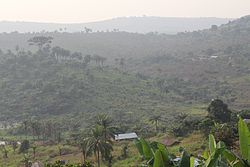Kwilu (provins)
| Kwilu | |
|---|---|
 Congolesisk skov-savanne mosaik | |
| Overblik | |
| Land | |
| Provinshovedstad | Bandundu |
| Grundlagt | 2015 |
| Demografi | |
| Indbyggere | 6.682.300 (2020)[1] |
| - Areal | 78.219 km² |
| - Befolkningstæthed | 85,4 pr. km² |
| Andet | |
| Koordinater | 5°2′S 18°49′Ø / 5.033°S 18.817°Ø |
| Oversigtskort | |
Kwilu er en provins i Den Demokratiske Republik Congo. Den er en af de 21 provinser, der blev oprettet ved opdelingen i 2015, og har navn efter Kwilufloden som løber gennem området fra sydøst til nordvest. Kwilu, Kwango, og Mai-Ndombe-provinserne er resultatet af opdelingen af den tidligere Bandundu-provinsen.[2] Kwilu blev dannet af Kwilu distrikt og de uafhængige byer Bandundu og Kikwit. Bandundu er provinsens hovedstad.[3] Provinsens befolkning blev i 2020 anslået til 6.682.300 indbyggere, der lever på et areal af 78.219 km².[4]
Administrative områder
Byer og territorier er:
- Bagata
- Bulungu
- Gungu
- Idiofa
- Mangai
- Masi-Manimba
Historie
Kwilu blev administreret som en provins fra 1962 til 1966, men i 1964 blev administrationen overtaget af centralregeringen på grund af Kwilu-oprøret (en) i det sydvestlige Congo. En oprørsadministration under Pierre Mulele drev det meste af Kwilu-provinsen fra januar 1964.[5] Provinsen blev generobret af den lovlige regering i juni 1965, og provinsregeringen blev genoprettet den 18. januar 1966, men provinsen blev slået sammen med Kwango-distriktet og Mai-Ndombe-distriktet for at skabe Bandundu-provinsen.
Referencer
- ^ www.citypopulation.de (fra Wikidata).
- ^ "RDC: démembrement effectif du Bandundu". Radio Okapi (fransk). 19. juli 2015. Arkiveret fra originalen 20. juli 2015. Hentet 4. juni 2020.
- ^ "Loi organique nº 15/006 du 25 mars 2015 portant fixation des limites des provinces et celles de la ville de Kinshasa" (PDF). Journal officiel de la République Démocratique du Congo (fransk) (Special udgave). 56. Article 15, col. 39. 28. marts 2015. Arkiveret (PDF) fra originalen 17. april 2020. Hentet 17. april 2020.
- ^ "Congo (Dem. Rep.): Provinces, Major Cities & Towns – Population Statistics, Maps, Charts, Weather and Web Information". www.citypopulation.de. Hentet 11. februar 2024.
- ^ Stephen L. Weigert, Angola: A Modern Military History 1961-2002, 16-22.
Medier brugt på denne side
Forfatter/Opretter: Derivative work: User:Profoss - Original work:NordNordWest, Licens: CC BY-SA 3.0
Location of Province (see file name) in Democratic Republic of the Congo
The national flag of the Democratic Republic of the Congo. Created according to the 2006 constitution : Son emblème est le drapeau bleu ciel, orné d’une étoile jaune dans le coin supérieur gauche et traversé en biais d’une bande rouge finement encadrée de jaune. (Its symbol is a sky blue flag, decorated with a yellow star in the upper left corner and crossed in the diagonal by a red strip with thin yellow borders) It seems to be identical, except for a lighter field hue, to the 1966–1971 flag.
Forfatter/Opretter: DFID - UK Department for International Development, Licens: CC BY-SA 2.0
A view over the foothills of Bandundu Province, in the Democratic Republic of the Congo, from the rural town of Masi Manimba, some 250 miles from Kinshasa. Although it looks beautiful, like much of DRC, Masi Manimba is a remote, poor, rural area. Despite having very fertile land, agricultural food production is limited, and acute malnutrition is a major public health issue across the country.
Background
UK aid supported the NGO Action Against Hunger to provide an emergency nutrition response in Masi Manimba in 2010. Since then, the community has taken some of the ideas that Action Against Hunger brought to them, and organised itself to tackle malnutrition from the ground up - by forming its own co-operative farms and self-support groups.
Read the full story at www.dfid.gov.uk/Stories/Case-Studies/2012/Sowing-the-seed...
Picture: Russell Watkins/Department for International Development
Terms of use
This image is posted under a Creative Commons - Attribution Licence, in accordance with the Open Government Licence. You are free to embed, download or otherwise re-use it, as long as you credit the source as Russell Watkins/Department for International Development'.Forfatter/Opretter: Darwinek, Licens: CC BY-SA 3.0
Flag-map of the Democratic Republic of the Congo




